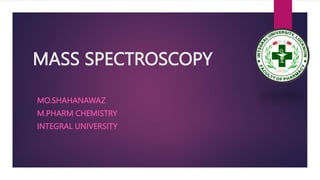
MASS SPECTROSCOPY.pptx
- 2. INTRODUCTION Mass spectroscopy is one of the primary spectroscopic methods for molecular analysis available to organic chemist. It is a micro analytical technique requiring only a few Nano moles of the sample to obtain characteristic information like structure and molecular weight of analyte. It is not concerned with non- destructive interaction between molecules and electromagnetic radiation. t involves the production and separation of ionized molecules and their ionic decomposition product and finally the measurement of the relative abundance of different ions produced. Mass spectroscopy is the most accurate method for determining the molecular mass of the compound and its elemental composition.
- 3. Mass spectrometry involves ionizing a sample to create charged particles (ions), separating the ions based on their mass-to-charge ratio (m/z), and detecting and measuring their abundance. It provides information about the molecular weight, structure, and composition of the sample. 1. Mass spectra is used in two general ways: 2. To prove the identity of compounds. To establish the structure of a new a compound. The mass spectrum of a compound helps to establish the structure of a new compound in several different ways: 1. It can give the exact molecular mass. 2. It can give a molecular formula or it can reveal the presence of certain structural units in a molecule.
- 4. PRINCIPLES Ionization:When sample is bombarded with a beam of energetic electrons; an electron gets removed from the sample leading to a positively charged radical ion also known as parent ion/molecular ion. The sample is ionized using various techniques like electron impact, electrospray ionization, matrix-assisted laser desorption/ionization (MALDI), or atmospheric pressure chemical ionization (APCI)
- 5. Acceleration: The ions are accelerated so that they all have the same kinetic energy The positive ions are repelled away from the positive ionization chamber and pass through the slits into a finely focused beam. Deflection: The ions are then deflected by a magnetic field according to their masses. The lighter they are, the more they are deflected. The amount of deflection also depends on the number of positive charges on the ion -The more the ion is charged, the more it gets deflected. Different ions are deflected by the magnetic field by different amounts. The amount of deflection depends on the mass of the ion, lighter ions are deflected more than heavier ones.
- 6. Ion Separation: The ions are then separated based on their mass-to-charge ratio Ion Detection: The separated ions are detected and converted into electrical signals. The ion detector measures the abundance of different ions based on their m/z values. Common types of analyzers includes 1. Quadrupole Mass Analyzer. 2. Time of Flight Mass Analyzer(TOF). 3. Magnetic Sector Mass Analyzer. 4. Electrostatic Sector Mass Analyzer. 5. Quadrupole Ion Trap Mass Analyzers. 6. Ion Cyclotron Resonance.
- 7. m/z
- 9. Types of fragmentation 1.Sigma electron ionisation: like homolytic dissociation in 2-butanone 2.Radical site initiation: α-cleavage occurs by donation of an electron to form new bond to an adjacent atom concomitant with cleavage of other bond to that atom.
- 10. 3.Charge site initiation: inductive cleavage involves the attraction of an electron pair by an electronegative heteroatom that ends up as a radical or neutral molecule. 4.Rearrangement: E.g. McLafferty rearrangement Fragmentation involves bond formation as well as bond breaking.
- 11. Mass fragmentation rules 1.The nitrogen rule: A molecular ion has an odd mass it must have an odd number of nitrogen A molecular ion with an even mass must lack or contain an even number of nitrogen atoms. 2.Stevenson’s rule: If two fragments are in competition to produce a cation, the fragment with the lowest ionization energy will be formed more frequently.
- 12. The Rule of 13: calculate possible chemical formula for a given molecular mass. First step: Assume that only carbon and hydrogen are present in the molecule (CH units having mass of 13). If the molecular weight of the molecule in question is M, the number of possible CH units is n:where r is the remainder. The base formula for the molecule is CnH {n+r} . M/13 = n + r /13
- 13. Mc-Lafferty rearrangement The rearrangement involves a six-membered ring transition state in which the carbonyl group pulls off the gamma proton, splitting the molecule into two pieces. These pieces consist of an enol radical cation and a neutral alkene fragment. For Mc-Lafferty rearrangement compound should have following properties It should have pi electron 1. It should have n electron 2. It should have gama Hydrogen
- 15. Application of Mc-Lafferty rearrangement 14+12+1+17=44 Group X m/z Aldehyde H 44 Ketone CH3 44+15-1=58 Acid OH 44+17-1=60 Amide NH2 44+16-1=59 Ester OCH3 44+16+15-1=74
- 16. THANK YOOU
